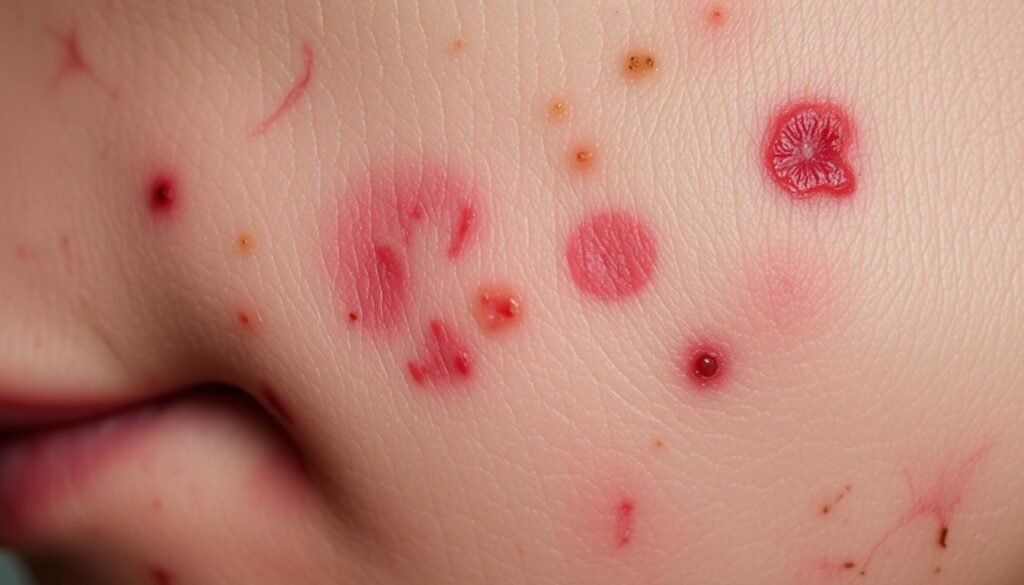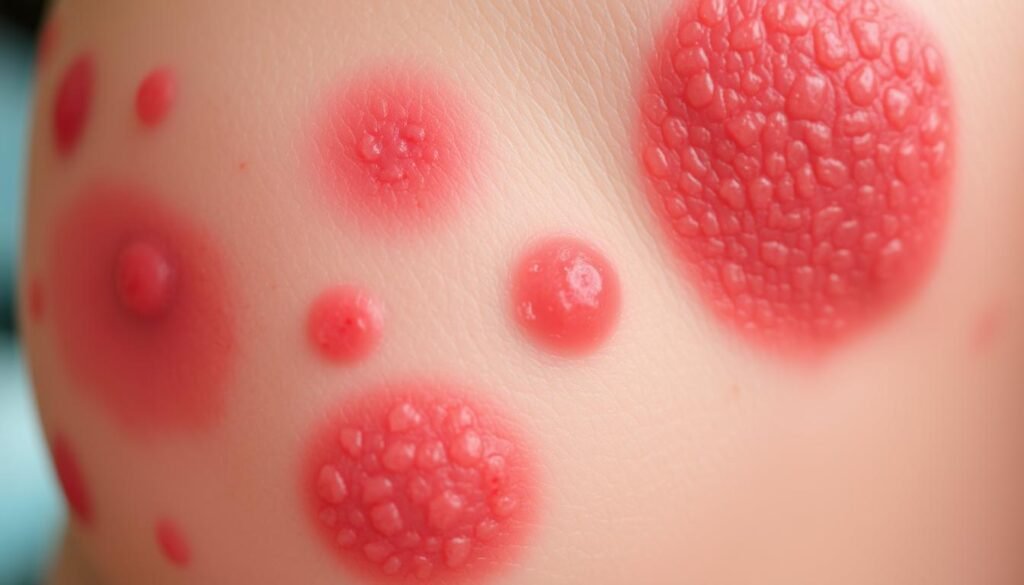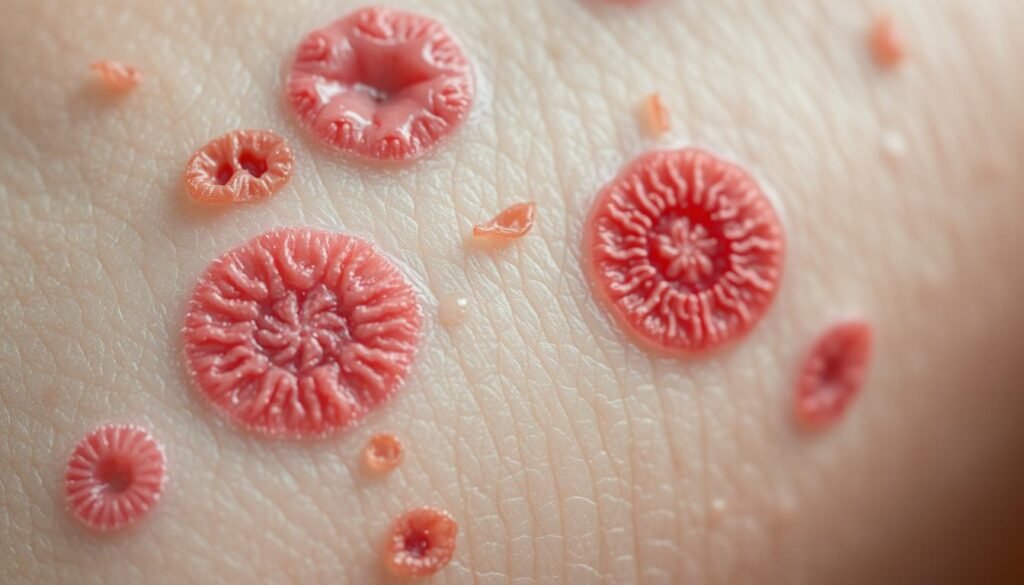About 30% of Americans are dealing with eczema. This condition gets worse with stress and anxiety. Our mental health plays a big role in our skin’s condition. Issues like anxiety can show up as real problems on our skin. This article will show you how stress and anxiety cause skin issues. We’ll look at skin conditions made worse by stress with real pictures. Check out skin conditions caused by stress to learn how feelings affect our skin.
Key Takeaways
- Stress can make skin problems like eczema and psoriasis worse.
- Anxiety can cause acne and hives to flare up more often.
- Knowing about skin issues caused by stress can help us deal with them better.
- Pictures help us see how stress affects skin on different people.
- It’s important to get a doctor’s help for skin problems caused by stress.
Understanding the Connection Between Stress and Skin Health
Stress and skin health have a deep link. Psychological stress can worsen skin conditions. Knowing how stress affects the skin helps us manage it better. When we’re stressed, our bodies release more cortisol. This hormone can increase inflammation and make skin problems like eczema worse.
How Stress Affects the Skin
Stress causes many reactions in our body that harm our skin. Key impacts include:
- Increased Inflammation: Stress makes skin more sensitive, worsening conditions like hives.
- Oil Production: It boosts oil production, leading to more acne for those at risk.
- Delayed Healing: Stress slows how fast wounds heal and skin recovers.
- Accelerated Aging: It speeds up aging by damaging collagen, which leads to wrinkles.
Scientific Insights on Stress-Induced Skin Issues
Research shows clear biological links between stress and skin health. Stress affects hormones like CRH in skin cells. This impacts cell growth and how skin reacts to stress. Too much cortisol affects our immune system and worsens skin issues. Those facing severe stress-induced skin problems should see a dermatologist. For tips on managing stress and skin health, check this resource.
Common Skin Conditions Linked to Stress
Stress makes a big difference in skin health, leading to what are known as stress-related skin issues. People who are prone to skin problems may see them get worse due to stress. Recognizing and dealing with these issues early is very important. Examples include acne, eczema, and rosacea which show how our emotions affect our skin.
Overview of Stress-Related Dermatological Issues
Several skin issues are closely linked with stress. Some of the most common are:
- Acne: Influences up to 50 million Americans each year, mainly teens and young adults. Stress can cause more oil production, making acne worse.
- Eczema: Over 31 million people in the US have eczema, which gets worse with stress, leading to itching and dry skin.
- Rosacea: Around 16 million Americans suffer from this chronic skin issue, mostly women. It’s often worsened by stress and environmental factors.
- Hives: Stress is one of the triggers for hives. They appear as welts on the skin but usually go away after 24 hours.
- Psoriasis: This condition affects 2-3% of the global population. Stress can make it worse, causing more outbreaks and severe symptoms.
Impact of Anxiety on Existing Skin Conditions
Anxiety can make skin problems even worse. People with eczema, for example, may feel more inflamed and itchy during stressful times. Those with psoriasis could see their skin getting bumpier. Stress, not drinking enough water, and not taking care of oneself can make these conditions worse, resulting in dull and dry skin.
Furthermore, stress can bring back cold sores, which are caused by a virus. They usually last about ten days. Tackling these stress-related skin issues can really help improve skin health overall.

| Skin Condition | Estimated Prevalence | Stress Impact |
|---|---|---|
| Acne | Affects up to 50 million annually | Increases oil production, triggering flare-ups |
| Eczema | Over 31 million in the U.S. | Worsens dryness and itchiness |
| Rosacea | Affects about 16 million | Aggravated by emotional stress |
| Hives | 20% of individuals at some point | Triggered by stress and allergic reactions |
| Psoriasis | 2-3% of the world’s population | High-stress levels lead to increased outbreaks |
Skin Conditions Caused by Stress and Anxiety Pictures
Looking at pictures can help us understand skin problems caused by stress better. This part shows real stress rashes images. They cover different conditions like hives, rashes, and acne because of stress. It helps people know when to get the right treatment.
Visual Examples of Stress-Induced Skin Problems
Stress can change how our skin looks in many ways. It’s important to know these signs. They include:
- Hives or welts on the skin, often found on the face, chest, and neck.
- Rashes that may appear suddenly and can be itchy or irritating.
- Inflammation or flare-ups of existing conditions like eczema and acne.

Understanding the Symptoms Through Imagery
Pictures are a strong way to see stress’s impact on the skin. The stress rashes images show different signs:
| Condition | Description | Visual Feature |
|---|---|---|
| Hives | Raised, itchy welts triggered by stress. | Red or skin-colored bumps appearing abruptly. |
| Rashes | Inflamed areas of skin, often itchy. | Varies in color from red to brown patches. |
| Acne Flare-Ups | Worsening of acne due to heightened stress levels. | Pustules and red inflammation on the face. |
For deeper understanding, we can learn more about stress and skin at this informative article. Seeing these symptoms helps us know when it’s time for professional help or home care.
The Role of Cortisol in Skin Health
Cortisol is key to our skin’s health, mainly when we’re stressed. It acts as a primary stress hormone. It greatly affects the skin’s outer layer, changing how well it holds moisture and guards against harmful elements. Problems like increased sensitivity, dryness, and other skin issues can arise from this.
Understanding Cortisol’s Effect on the Epidermal Barrier
When cortisol levels are high, our skin’s outer barrier gets weaker. It becomes less effective at keeping moisture in. This leads to dry, irritated skin that’s more open to allergens and irritants. With a weaker barrier, conditions like eczema and psoriasis can surface more easily. These conditions get worse with inflammation, leading to ongoing skin problems and damage.
Stress Hormones and Skin Inflammation
Stress hormones, especially cortisol, can cause inflammation in the skin. This can result in acne, rashes, and other skin issues. Higher cortisol can also make sebaceous glands produce more oil, leading to more acne. Chronic stress makes skin problems worse and slows down healing. So, managing stress is crucial for keeping skin healthy and avoiding inflammation.

Acne and Stress: A Vicious Cycle
Stress significantly impacts acne. It triggers physiological reactions in our bodies. When we’re stressed, we produce more cortisol. This hormone makes skin glands produce more oil. Too much oil can block pores causing acne, especially in those prone to it.
How Stress Triggers Acne Flare-Ups
Stress can make pimples and nodules that are sore appear. High cortisol levels increase oil production. They also make acne last longer and can be more severe. Statistics show that 85% of people will deal with acne at some point in their lives. Factors leading to worse acne include:
- Increased oil production in the skin.
- Delayed healing of existing acne lesions.
- Exacerbation of inflammation in pre-existing acne conditions.
To treat this, use skincare products with salicylic or mandelic acid. Managing stress with deep breathing and exercising also helps control acne.
Pictures of Stress-Induced Acne
To understand stress-acne better, pictures are helpful. High-quality pictures of stress-induced acne show its typical effects. It shows the places where acne appears most often, like the face, back, and shoulders.
Knowing the symptoms of stress-induced acne leads to faster treatment. Clear skin comes from combining good internal health practices and skincare. Include a balanced diet and proper hydration for best results.
Exploring Eczema and Psoriasis Exacerbation Due to Stress
Stress can worsen eczema and psoriasis, making the skin look worse. Seeing these changes can be upsetting. It helps to use tension eczema illustrations to spot stress-related flare-ups. Spotting these early is key to managing them well.
Recognizing the Symptoms in Pictures
Eczema and psoriasis have similarities but also key differences. Eczema shows up as red, itchy spots, often on the face, neck, and limbs, mainly in kids. Psoriasis usually affects adults with thick, scaly patches on the knees, elbows, and scalp. Pictures that show these symptoms can help identify flare-ups.
- Eczema Symptoms: Red, itchy patches, often with dry and scaly skin.
- Common Locations: Face, neck, inside the bends of arms and knees.
- Psoriasis Symptoms: Thick, raised, scaly patches that can be painful or itchy.
- Common Locations: Elbows, knees, scalp, and lower back.
Stress can make both conditions worse, leading to more severe symptoms. Managing stress is vital for treatment. By knowing what triggers flare-ups and looking at images, people can better understand their skin conditions. This includes conditions like stress-induced psoriasis and different types of eczema.
Dealing with Stress Rashes and Hives
Understanding stress rashes and hives is crucial for effective management. Stress can lead to hives. These are raised, red welts on the skin. They are also known as stress-induced or worry rashes. They can show up anywhere on your body. Their size and severity may vary. Looking at pictures of stress hives can help you recognize them. This way, you can tell them apart from other skin issues.
Identification Through Visual Cues
Visual cues are key in pinpointing stress-related skin problems. Symptoms of stress rashes can include:
- Raised welts or spots on the skin
- Itching or a burning sensation
- Variations in color and size
Short-term hives usually clear up in a few days. But chronic hives stick around for over six weeks. Studies show that stress can set off these reactions. This can make conditions like eczema and psoriasis worse. Checking out examples of worry rashes can help you know when to seek help.
Impacts of Mental Tension on Skin Health
Mental tension can hit skin health hard. The body responds to stress by releasing hormones like cortisol. This can cause inflammation and skin problems. Long-term stress is linked to various skin issues. It’s important to look after both your mental and physical health.
There are steps to take if you have stress rashes. Try regular exercise, balanced diets, and mindfulness to lower stress. For managing hives or rashes, antihistamines or cooling treatments may help. If these symptoms don’t improve, see a dermatologist for more advice.
| Type of Hives | Duration | Treatment Options |
|---|---|---|
| Acute Hives | Less than 6 weeks | Antihistamines, cooling gels |
| Chronic Hives | More than 6 weeks | Prescription antihistamines, corticosteroids |
In summary, being able to identify stress hives is key. Knowing how they differ from other conditions can lead to quicker and better care for your skin.
Preventative Measures and Treatments
Stress can greatly affect your skin’s health. If you’re dealing with stress-related skin issues, try specific strategies. These methods can help you tackle skin problems and boost your overall health.
Effective Strategies to Mitigate Stress-Related Skin Issues
To lessen stress and better your skin, implement these strategies. Here’s what can help:
- Stay Hydrated: Drinking enough water keeps your skin moist and healthy.
- Topical Treatments: Gentle moisturizers protect and calm your skin.
- Relaxation Techniques: Yoga, meditation, and deep breathing cut down stress.
- Regular Exercise: Working out releases endorphins, reducing stress and boosting blood flow.
- Nutritional Supplements: Supplements like Regul8 Relax with herbs support skin by easing stress.
Skin Care Tips for Stressful Times
To care for your skin during stress, adopt certain habits. Adding these to your daily routine can make your skin more resilient:
- Use fragrance-free products to lessen irritation.
- Choose non-comedogenic makeup to avoid acne.
- Add soothing elements like aloe vera and chamomile to your skincare.
- Have a regimen with gentle cleansing and moisture, especially for sensitive areas.
- Talk to a dermatologist for advice on stress-related skin care.
For ongoing skin issues or serious reactions, getting medical advice is key. To understand more about how stress impacts skin, check out this informative resource.
| Skin Condition | Stress Impact | Recommended Treatment |
|---|---|---|
| Acne | Increased breakouts due to cortisol | Topical retinoids, over-the-counter solutions |
| Eczema | Irritation, redness, and itchiness | Moisturizers, corticosteroids |
| Psoriasis | Worsening of scaly patches | Prescription treatments, phototherapy |
| Dry Skin | Less oil production leading to moisture loss | Hydrating lotions, humectants |
By using these skincare tips for stressful periods and noticing the signs for professional help, you can work towards better skin health during tough times.
Conclusion
Understanding how stress affects our skin is key. It lets us see the link between our feelings and skin health. Stress can cause skin problems like rashes and worsen eczema or psoriasis. Knowing this helps us take care of our mental and physical health better.
Chronic stress makes the body react in ways that can hurt our skin. It can cause things like histamine to release, leading to skin issues. When we understand this, we can seek better treatments. These might be therapy or adding meditation and exercise to our day. Making these changes can improve our skin and how we feel inside.
It’s important to treat both our emotions and our skin together. Knowing the signs of stress-related skin problems helps us act early. We can then reduce stress to help our skin. With the right approach, we can lessen emotional and physical stress. This improves both our mood and our skin’s health.